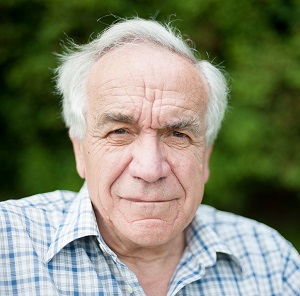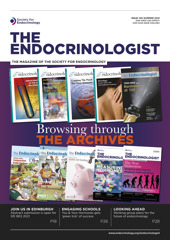Mrs Bisbee was the author of no papers on endocrinology, but yet she was the mentor of pioneering endocrinologists, founders of Journal of Endocrinology and stalwarts of this Society who, in turn, propagated the subject in many parts of the world.
THE BEST LECTURER EVER ENCOUNTERED
I first heard of this lecturer at the University of Liverpool from John Phillips (Chairman of the Society for Endocrinology, 1981–1984) and Alan Wright (both Liverpool graduates) in Hong Kong in 1966. I remember the line, ‘… she started everybody off’. Only recently have I uncovered just who some of the ‘everybody’ were, and something of her sad private life.
Readers of Lord Zuckerman’s autobiography From Apes to Warlords 1904–461 cannot fail to notice his praise of Mrs Bisbee, who was seconded to the University of Cape Town in 1924. He commented on her inspirational lectures and her encouragement of his research on reproduction in baboons. That led directly to his work in London and, in turn, to the launch of Journal of Endocrinology in 1939 (which Zuckerman edited for many years) and the Society for Endocrinology in 1946.
'The importance of Mrs Bisbee in fostering endocrinology in its early days is clear. But who was this ‘remarkable lecturer’?'
At Liverpool in the 1930s, Mrs Bisbee supervised postgraduate students in research on endocrinological topics that she initiated. ‘Harry’ Waring (1910–1980), who went on to become the doyen of environmental physiology and endocrinology in Western Australia, did seminal work on the mouse adrenal. He noted that she suggested the topic while helping and criticising throughout. Similarly, in his biographical memoir for the Royal Society, James ‘Jimmie’ Munro Dodd (1915–1986) records his indebtedness to her for getting him interested in comparative endocrinology. He described her as quite the best lecturer he ever encountered. Ian Chester Jones (1916–1986) (Dale Medallist in 1976 and former Secretary of the Society for Endocrinology) was also steered to work, like Waring, on the mouse adrenal.
The importance of Mrs Bisbee in fostering endocrinology in its early days is clear. But who was this ‘remarkable lecturer’? With the help of genealogical search sites, old newspapers and material in the archives of the University of Liverpool, I have found something about her, as well as the tribulations of being a female university scientist in Britain in the first half of the 20th century.
A WOMAN IN 20TH CENTURY SCIENCE
Ruth Culshaw Bamber, the daughter of a gamekeeper, was born on 30 November 1889 near Ormskirk in Lancashire, UK. She graduated from Liverpool with first class honours in 1913, followed by an MSc in 1914. She was appointed lecturer in 1915. In 1919, her life changed, but not in the way she expected. She had met an American, George Allen Bisbee, who was working for the YMCA in Liverpool near the end of the First World War. In 1919, she sailed to New York where they were married on the day the ship arrived. However, something must have gone wrong because instead of living in Pittsburgh, as was her intention, she sailed back to Liverpool 2 weeks later.
The marriage was annulled sometime in the early 1920s. However, she had become a US citizen by dint of marriage and, in 1924, had to apply for renaturalisation. Her travails did not end there. She had not told the university of the annulment (an unmentionable subject at the time) and when, in 1933, the university decided that all married women must resign and re-apply for a post, she was included in that edict, which is remarkable to 21st century eyes.
She did as instructed, but withdrew her resignation when her true status was revealed. The whole affair became a cause célèbre for women’s employment and the university was forced to reverse its policy in 1934. The vice-chancellor responsible for the policy sailed on to become Principal of Glasgow University with a knighthood.
'Mrs Bisbee’s scientific children, grandchildren and great-grandchildren spread throughout the world, from Hong Kong in the east to California in the west. They have served the Society for Endocrinology as officers and editors.'
Her personal research (after 1919 always published using the style ‘Ruth C Bamber (Mrs Bisbee)’) ranged from marine biology to genetics. She became well known for her work on coat colour in cats. From papers in which she is acknowledged for having the idea for a student’s research project (no just adding a supervisor’s name to a paper then), her confidence in matters endocrinological must have been sufficient in the early 1930s to launch students into the field.
Ruth Culshaw Bamber (Mrs Bisbee) retired, still a lecturer, in 1955. She died on 7 January 1970, aged 80, near Kendal in the English Lake District.
Mrs Bisbee’s scientific children, grandchildren and great-grandchildren spread throughout the world, from Hong Kong in the east to California in the west. They have served the Society for Endocrinology as officers and editors.
Perhaps we should do more to commemorate her as the foster mother of the science of endocrinology in Britain.
MALCOLM PEAKER
Malcolm Peaker FRS was Director of the Hannah Research Institute until he retired in 2003.
REFERENCE
1. Zuckerman S 1978 From Apes to Warlords 1904–46. London, UK: Hamish Hamilton Ltd.
Despite his best efforts, Malcolm Peaker has been unable to track down an archive photograph of Ruth C Bamber/Mrs Bisbee. If you can help, contact your Society and we'll put you in touch.






